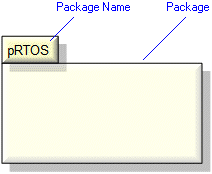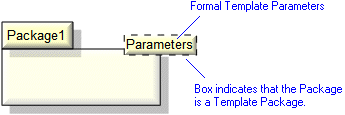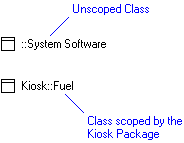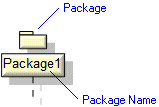Package (dictionary item)

For automation interface information about a Package, see
Package (automation interface).
Packages allow you to organize items and diagrams in a model. Each item in a model must be scoped by a Package or the model itself. By adding Packages to other Packages, you can create a Package hierarchy in a model. Through the Packages pane, you can quickly maintain the Package hierarchy and the content of each Package through drag-and-drop operations.
In addition to scoping (packaging) items, Packages:
Specify the access permissions of the items they contain. For more information about model item access permissions, see
Overview of model item access permissions.
Provide configuration control to the items they contain. For more information about using Modeler with configuration management tools, see
Overview of configuration management tool integration.
Ensure that you consider security and source control needs when creating a Package hierarchy in a model.
For detailed information about how item and diagram types are scoped by Packages, see
Overview of packages.
Important When you delete a Package, Modeler deletes the Package and all items scoped by that Package.
You can create a Package through the context menu of a Model or Package: right-click the Model or Package, and select > . You can also create a Package through a Class Diagram.
On the Class Diagram, dragging an item to a Package rescopes that item to the Package.
When used on a Class Diagram or Profile Diagram, a Package's notation is as follows:

On a Class Diagram you can show Package ownership of another item through a Nesting Link. You can populate nesting links on a Class Diagram – right-click the diagram background, and select > . Creating a new Nesting Link scopes the nested item to the nesting item.

If the Package is a template Package, a Package's notation is as follows:

When an item is scoped by a Package, its full name typically reflects the scoping of the Package.

When used on a Sequence Diagram, a Package's notation is as follows:

For information about the View Options available for this symbol, see the following:
When Modeler is integrated with a configuration management tool, a Package's symbol in the Package and Relationship panes changes to indicate its status.
When under configuration control, a Package icon can include a lock, pencil, outgoing arrow and incoming arrow:
 means you do not have write access to the Package.
means you do not have write access to the Package. means you do have write access to the Package.
means you do have write access to the Package. means the Package is under configuration control and is checked out by you to the Modeler model.
means the Package is under configuration control and is checked out by you to the Modeler model. means the Package is under configuration control and is not checked out by you.
means the Package is under configuration control and is not checked out by you.A Package icon can appear as follows:

• The Package is not under configuration control.
• You have write access to the Package.

• The Package is not under configuration control.
• You do not have write access to the Package.

• The Package is under configuration control.
• The Package is checked out by you to the Modeler Model.
• You have write access to the Model or Package.

• The Package is under configuration control.
• The Package is checked out by another user to the Modeler Model.
• You have write access to the Package.

• The Package is under configuration control.
• The Package is not checked out by you to the Model.
• You do not have write access to the Package. Note that a check in operation protects a Package, so that no users of the Model will have write access to the Package.

• The Package is under configuration control.
• The Package is checked out by you to the Modeler Model.
• You do not have write access to the Package.
 This symbol displayed to the left of a Package symbol indicates that the Package is shared in the CM tool.
This symbol displayed to the left of a Package symbol indicates that the Package is shared in the CM tool. A short-cut symbol on a Package's icon indicates that the item is a stub.
A short-cut symbol on a Package's icon indicates that the item is a stub.Red check marks and crosses appear on Package symbols only if you are a valid and licensed user of the integrated configuration management tool. |
The following sections provide information about how a Package is used in the model. For more information about a property, item, model part or diagram, click it.
Properties
In addition to the standard properties, a Package has these properties:
·
Merge Permissions (Merge Package Permissions through the automation interface)
·
Package Item Order (not accessible through the automation interface)
Owned by
Owns
 Board - Note that in the opposite direction this link means that the Package's software resides on the Board. For more information, see
Linking a package with a board.
Board - Note that in the opposite direction this link means that the Package's software resides on the Board. For more information, see
Linking a package with a board. Dependency - The Dependency is owned jointly by the Package and the associated Package or Class. The access permissions you have to a Dependency are determined by the access permissions of the dependent item.
Dependency - The Dependency is owned jointly by the Package and the associated Package or Class. The access permissions you have to a Dependency are determined by the access permissions of the dependent item.Defined in these parts of the model
Used in:
Shown on these diagrams
For information about how the View Options affect the presentation of Packages, see
Package view options - class diagram.
Can be linked to these dictionary items
In addition to the owning
Package or
Model and the items a Package can own, a Package can be linked to the following items.
 Board - The Package's software resides on the linked Board. Note that in the opposite direction this link means that the Package owns the Board. For more information, click here
Package view options - class diagram.
Board - The Package's software resides on the linked Board. Note that in the opposite direction this link means that the Package owns the Board. For more information, click here
Package view options - class diagram.• If you use the Links Editor to link the Package to a Stereotype, the Stereotype is applied to the Package without making the Package the parent of the Stereotype. |
 Model
Model Activity
Activity Actor
Actor Attribute
Attribute Board IO Device Type
Board IO Device Type Board Type
Board Type Change Note
Change Note Channel
Channel Class
Class Class Diagram
Class Diagram Comment
Comment Communication Diagram
Communication Diagram Composite Structure Diagram
Composite Structure Diagram Concurrency Diagram
Concurrency Diagram Constraint
Constraint Constraints Diagram
Constraints Diagram Constraint Type
Constraint Type Data Type
Data Type Database
Database Disk
Disk Disk Type
Disk Type Event
Event Event Flag
Event Flag Exception
Exception Formal Template Parameter
Formal Template Parameter General Flow Diagram
General Flow Diagram General Graphics Diagram
General Graphics Diagram Increment
Increment Instance
Instance Interface
Interface Interface Device
Interface Device Interface Device Type
Interface Device Type Mailbox
Mailbox Memory Type
Memory Type Monitor
Monitor Multidrop Bus
Multidrop Bus Multidrop Bus Type
Multidrop Bus Type Object Diagram
Object Diagram Operation
Operation Point to Point Connection Type
Point to Point Connection Type Pool
Pool Processor Type
Processor Type Profile Diagram
Profile Diagram Semaphore
Semaphore Script
Script Sequence Diagram
Sequence Diagram Signal
Signal State Machine
State Machine Stereotype
Stereotype Subsystem
Subsystem Synchronizer
Synchronizer System Architecture Diagram
System Architecture Diagram Table
Table Table Relationships Diagram
Table Relationships Diagram Task
Task Ternary Association
Ternary Association Text Diagram
Text Diagram Type Definition
Type Definition Use Case
Use Case Use Case Diagram
Use Case Diagram Variant Diagram
Variant Diagram Class Model
Class Model